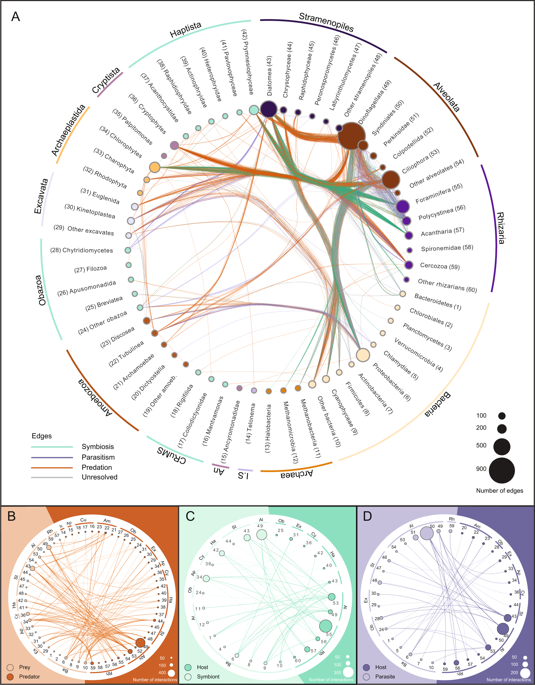Our official English website, www.x-mol.net, welcomes your
feedback! (Note: you will need to create a separate account there.)
The planktonic protist interactome: where do we stand after a century of research?
The ISME Journal ( IF 10.8 ) Pub Date : 2019-11-04 , DOI: 10.1038/s41396-019-0542-5 Marit F Markussen Bjorbækmo 1 , Andreas Evenstad 1 , Line Lieblein Røsæg 1 , Anders K Krabberød 1 , Ramiro Logares 1, 2
The ISME Journal ( IF 10.8 ) Pub Date : 2019-11-04 , DOI: 10.1038/s41396-019-0542-5 Marit F Markussen Bjorbækmo 1 , Andreas Evenstad 1 , Line Lieblein Røsæg 1 , Anders K Krabberød 1 , Ramiro Logares 1, 2
Affiliation

|
Microbial interactions are crucial for Earth ecosystem function, but our knowledge about them is limited and has so far mainly existed as scattered records. Here, we have surveyed the literature involving planktonic protist interactions and gathered the information in a manually curated Protist Interaction DAtabase (PIDA). In total, we have registered ~2500 ecological interactions from ~500 publications, spanning the last 150 years. All major protistan lineages were involved in interactions as hosts, symbionts (mutualists and commensalists), parasites, predators, and/or prey. Predation was the most common interaction (39% of all records), followed by symbiosis (29%), parasitism (18%), and 'unresolved interactions' (14%, where it is uncertain whether the interaction is beneficial or antagonistic). Using bipartite networks, we found that protist predators seem to be 'multivorous' while parasite-host and symbiont-host interactions appear to have moderate degrees of specialization. The SAR supergroup (i.e., Stramenopiles, Alveolata, and Rhizaria) heavily dominated PIDA, and comparisons against a global-ocean molecular survey (TARA Oceans) indicated that several SAR lineages, which are abundant and diverse in the marine realm, were underrepresented among the recorded interactions. Despite historical biases, our work not only unveils large-scale eco-evolutionary trends in the protist interactome, but it also constitutes an expandable resource to investigate protist interactions and to test hypotheses deriving from omics tools.
中文翻译:

浮游原生生物相互作用组:经过一个世纪的研究,我们站在哪里?
微生物相互作用对地球生态系统功能至关重要,但我们对它们的了解有限,迄今为止主要以零散记录的形式存在。在这里,我们调查了涉及浮游原生生物相互作用的文献,并在手动策划的原生生物相互作用数据库 (PIDA) 中收集了信息。在过去的 150 年里,我们总共从约 500 篇出版物中登记了约 2500 次生态互动。所有主要的原生生物谱系都参与了作为宿主、共生体(共生体和共生体)、寄生虫、捕食者和/或猎物的相互作用。捕食是最常见的相互作用(占所有记录的 39%),其次是共生(29%)、寄生(18%)和“未解决的相互作用”(14%,其中不确定相互作用是有益还是拮抗)。使用二分网络,我们发现原生捕食者似乎是“多食性的”,而寄生虫-宿主和共生体-宿主的相互作用似乎具有中等程度的专业化。SAR 超群(即 Stramenopiles、Alveolata 和 Rhizaria)在 PIDA 中占主导地位,与全球海洋分子调查(TARA Oceans)的比较表明,在海洋领域丰富多样的几个 SAR 谱系在记录的互动。尽管存在历史偏见,但我们的工作不仅揭示了原生生物相互作用组的大规模生态进化趋势,而且还构成了研究原生生物相互作用和检验来自组学工具的假设的可扩展资源。而寄生虫-宿主和共生体-宿主的相互作用似乎具有中等程度的专业化。SAR 超群(即 Stramenopiles、Alveolata 和 Rhizaria)在 PIDA 中占主导地位,与全球海洋分子调查(TARA Oceans)的比较表明,在海洋领域丰富多样的几个 SAR 谱系在记录的互动。尽管存在历史偏见,但我们的工作不仅揭示了原生生物相互作用组的大规模生态进化趋势,而且还构成了研究原生生物相互作用和检验来自组学工具的假设的可扩展资源。而寄生虫-宿主和共生体-宿主的相互作用似乎具有中等程度的专业化。SAR 超群(即 Stramenopiles、Alveolata 和 Rhizaria)在 PIDA 中占主导地位,与全球海洋分子调查(TARA Oceans)的比较表明,在海洋领域丰富多样的几个 SAR 谱系在记录的互动。尽管存在历史偏见,但我们的工作不仅揭示了原生生物相互作用组的大规模生态进化趋势,而且还构成了研究原生生物相互作用和检验来自组学工具的假设的可扩展资源。与全球海洋分子调查 (TARA Oceans) 的比较表明,在记录的相互作用中,几个在海洋领域丰富多样的 SAR 谱系的代表性不足。尽管存在历史偏见,但我们的工作不仅揭示了原生生物相互作用组的大规模生态进化趋势,而且还构成了研究原生生物相互作用和检验来自组学工具的假设的可扩展资源。与全球海洋分子调查 (TARA Oceans) 的比较表明,在记录的相互作用中,几个在海洋领域丰富多样的 SAR 谱系的代表性不足。尽管存在历史偏见,但我们的工作不仅揭示了原生生物相互作用组的大规模生态进化趋势,而且还构成了研究原生生物相互作用和检验来自组学工具的假设的可扩展资源。
更新日期:2020-01-17
中文翻译:

浮游原生生物相互作用组:经过一个世纪的研究,我们站在哪里?
微生物相互作用对地球生态系统功能至关重要,但我们对它们的了解有限,迄今为止主要以零散记录的形式存在。在这里,我们调查了涉及浮游原生生物相互作用的文献,并在手动策划的原生生物相互作用数据库 (PIDA) 中收集了信息。在过去的 150 年里,我们总共从约 500 篇出版物中登记了约 2500 次生态互动。所有主要的原生生物谱系都参与了作为宿主、共生体(共生体和共生体)、寄生虫、捕食者和/或猎物的相互作用。捕食是最常见的相互作用(占所有记录的 39%),其次是共生(29%)、寄生(18%)和“未解决的相互作用”(14%,其中不确定相互作用是有益还是拮抗)。使用二分网络,我们发现原生捕食者似乎是“多食性的”,而寄生虫-宿主和共生体-宿主的相互作用似乎具有中等程度的专业化。SAR 超群(即 Stramenopiles、Alveolata 和 Rhizaria)在 PIDA 中占主导地位,与全球海洋分子调查(TARA Oceans)的比较表明,在海洋领域丰富多样的几个 SAR 谱系在记录的互动。尽管存在历史偏见,但我们的工作不仅揭示了原生生物相互作用组的大规模生态进化趋势,而且还构成了研究原生生物相互作用和检验来自组学工具的假设的可扩展资源。而寄生虫-宿主和共生体-宿主的相互作用似乎具有中等程度的专业化。SAR 超群(即 Stramenopiles、Alveolata 和 Rhizaria)在 PIDA 中占主导地位,与全球海洋分子调查(TARA Oceans)的比较表明,在海洋领域丰富多样的几个 SAR 谱系在记录的互动。尽管存在历史偏见,但我们的工作不仅揭示了原生生物相互作用组的大规模生态进化趋势,而且还构成了研究原生生物相互作用和检验来自组学工具的假设的可扩展资源。而寄生虫-宿主和共生体-宿主的相互作用似乎具有中等程度的专业化。SAR 超群(即 Stramenopiles、Alveolata 和 Rhizaria)在 PIDA 中占主导地位,与全球海洋分子调查(TARA Oceans)的比较表明,在海洋领域丰富多样的几个 SAR 谱系在记录的互动。尽管存在历史偏见,但我们的工作不仅揭示了原生生物相互作用组的大规模生态进化趋势,而且还构成了研究原生生物相互作用和检验来自组学工具的假设的可扩展资源。与全球海洋分子调查 (TARA Oceans) 的比较表明,在记录的相互作用中,几个在海洋领域丰富多样的 SAR 谱系的代表性不足。尽管存在历史偏见,但我们的工作不仅揭示了原生生物相互作用组的大规模生态进化趋势,而且还构成了研究原生生物相互作用和检验来自组学工具的假设的可扩展资源。与全球海洋分子调查 (TARA Oceans) 的比较表明,在记录的相互作用中,几个在海洋领域丰富多样的 SAR 谱系的代表性不足。尽管存在历史偏见,但我们的工作不仅揭示了原生生物相互作用组的大规模生态进化趋势,而且还构成了研究原生生物相互作用和检验来自组学工具的假设的可扩展资源。









































 京公网安备 11010802027423号
京公网安备 11010802027423号